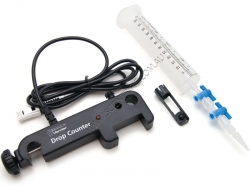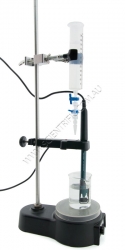
Drop counter components.
Enlarge

Drop Counter mounted on Vernier STIR Station. Beaker, retort clamp and STIR Station are not included.
Enlarge

Drop counter components.
Enlarge

Drop Counter mounted on Vernier STIR Station. Beaker, retort clamp and STIR Station are not included.
Enlarge
Vernier Drop Counter
Order code: VDC-BTD
VERNIER DROP COUNTER
The Drop Counter precisely records the number of drops of titrant added during a titration, which is automatically converted into volume. It may be used in conjunction with other sensors, such as a pH Sensor, Conductivity Probe or ORP Sensor to perform conductimetric or potentiometric titrations.
The Vernier Drop Counter has many features that help simplify its use:
• Adjustable clamp fits most laboratory ring stands and lattices
• Wide drop-detecting area
• Large sensor slot fits most conventional stick-style sensors
• Smaller adjustable slot for temperature sensors
• Accurate drop counting at rates up to 6 drops/second
Requirements:
This sensor requires suitable software and an interface such as one of the Vernier LabQuest variations.
For comprehensive details of the possible sensor/interface/software combinations see the Compatibility Guide link below.
Included:
• Vernier Drop Counter
• Plastic reagent reservoir
• Plastic valve with a double stopcock fitting
• Vernier Microstirrer MSTIR (additional microstirrers can be purchased)
• User manual
Educational use only:
Vernier and Kidwind products are designed for educational use. They are not appropriate for industrial, medical or commercial applications. Details
Warranty
- Warranty: 5 year limited warranty
Dimensions- Package size (HxWxD): 57x89x178mm
- Packed weight: 180g
Last edited 9th Jan 2025
 This product is used in teaching these Australian Curriculum codes:
This product is used in teaching these Australian Curriculum codes:
ACSCH063 - Molecular interactions and reactions - Aqueous solutions and acidity - The concentration of a solution is defined as the amount of solute divided by the amount of solution; this can be represented in a variety of ways including by the number of moles of the solute per litre of solution (mol L1) and the mass of the solute pe
ACSCH066 - Molecular interactions and reactions - Aqueous solutions and acidity - The pH scale is used to compare the levels of acidity or alkalinity of aqueous solutions; the pH is dependent on the concentration of hydrogen ions in the solution
ACSCH064 - Molecular interactions and reactions - Aqueous solutions and acidity - The presence of specific ions in solutions can be identified using analytical techniques based on chemical reactions, including precipitation and acidbase reactions
ACSCH097 - Equilibrium acids and redox reactions - Chemical equilibrium systems - Acids are substances that can act as proton (hydrogen ion) donors and can be classified as monoprotic or polyprotic depending on the number of protons donated by each molecule of the acid
ACSCH101 - Equilibrium acids and redox reactions - Chemical equilibrium systems - Acidbase indicators are weak acids or bases where the acidic form is of a different colour to the basic form
ACSCH091 - Equilibrium acids and redox reactions - Chemical equilibrium systems - Over time, physical changes and reversible chemical reactions reach a state of dynamic equilibrium in a closed system, with the relative concentrations of products and reactants defining the position of equilibrium
ACSCH100 - Equilibrium acids and redox reactions - Chemical equilibrium systems - The pH scale is a logarithmic scale and the pH of a solution can be calculated from the concentration of hydrogen ions; Kw can be used to calculate the concentration of hydrogen ions from the concentration of hydroxide ions in a solution
ACSCH099 - Equilibrium acids and redox reactions - Chemical equilibrium systems - The relationship between acids and bases in equilibrium systems can be explained using the Brønsted Lowry model and represented using chemical equations that illustrate the transfer of hydrogen ions
ACSCH098 - Equilibrium acids and redox reactions - Chemical equilibrium systems - The strength of acids is explained by the degree of ionisation at equilibrium in aqueous solution, which can be represented with chemical equations and equilibrium constants (Ka)
ACSCH102 - Equilibrium acids and redox reactions - Chemical equilibrium systems - Volumetric analysis methods involving acidbase reactions rely on the identification of an equivalence point by measuring the associated change in pH, using chemical indicators or pH meters, to reveal an observable end point
Click a curriculum code to see other products that relate.
| Accessories / Spare Parts: | From |
| MSTIR - Vernier Microstirrer | $22.00 |
| PS-2WAY - Vernier Plastic 2-Way Valve | $5.00 |
| PS-STEM - Vernier Stopper Stem | $2.00 |
| VDC-RR - Vernier Replacement Reservoir 2 Valves and Tips | $26.00 |
| Works with: | From |
| LABQ2 - Vernier LabQuest 2 Data Logger and Interface | |
| LQ-MINI - Vernier LabQuest Mini Data Logger Interface | $470.00 |
| LQ-STREAM - Vernier LabQuest Stream Wireless Data Logger | $698.00 |
| GA4 - Vernier Graphical Analysis | |
| TMP-BTA - Vernier Stainless Steel Temperature Probe | $112.00 |
| PH-BTA - Vernier pH Sensor | $261.00 |
| FPH-BTA - Vernier Tris Compatible Flat pH Sensor | $308.00 |
| CON-BTA - Vernier Conductivity Probe | $321.00 |
| ESUP - Vernier Electrode Support | $25.00 |
| ORP-BTA - Vernier ORP Sensor | $301.00 |
| CHEM-A - Advanced Chemistry with Vernier | $147.00 |
| CWV - Chemistry with Vernier | $147.00 |
| Similar Products: | From |
| GDX-DC - Vernier Go Direct Drop Counter | $286.00 |
Documents: Catalogue | Vernier Catalogue K-12 | Catalogue | Vernier Catalogue Uni | Catalogue | Scientrific April 2025 Mini Catalogue | Catalogue | Vernier 2025 K-12 Catalogue | Catalogue | Vernier 2025 University Catalogue | Compatibility Guide | Sensor-Interface-Software Requirements (external link) | Experiment | Acid Base Titration | Old User Manual | Old Vernier Drop Counter | | |||||||||||||||||
Note: Prices do NOT include GST or freight


